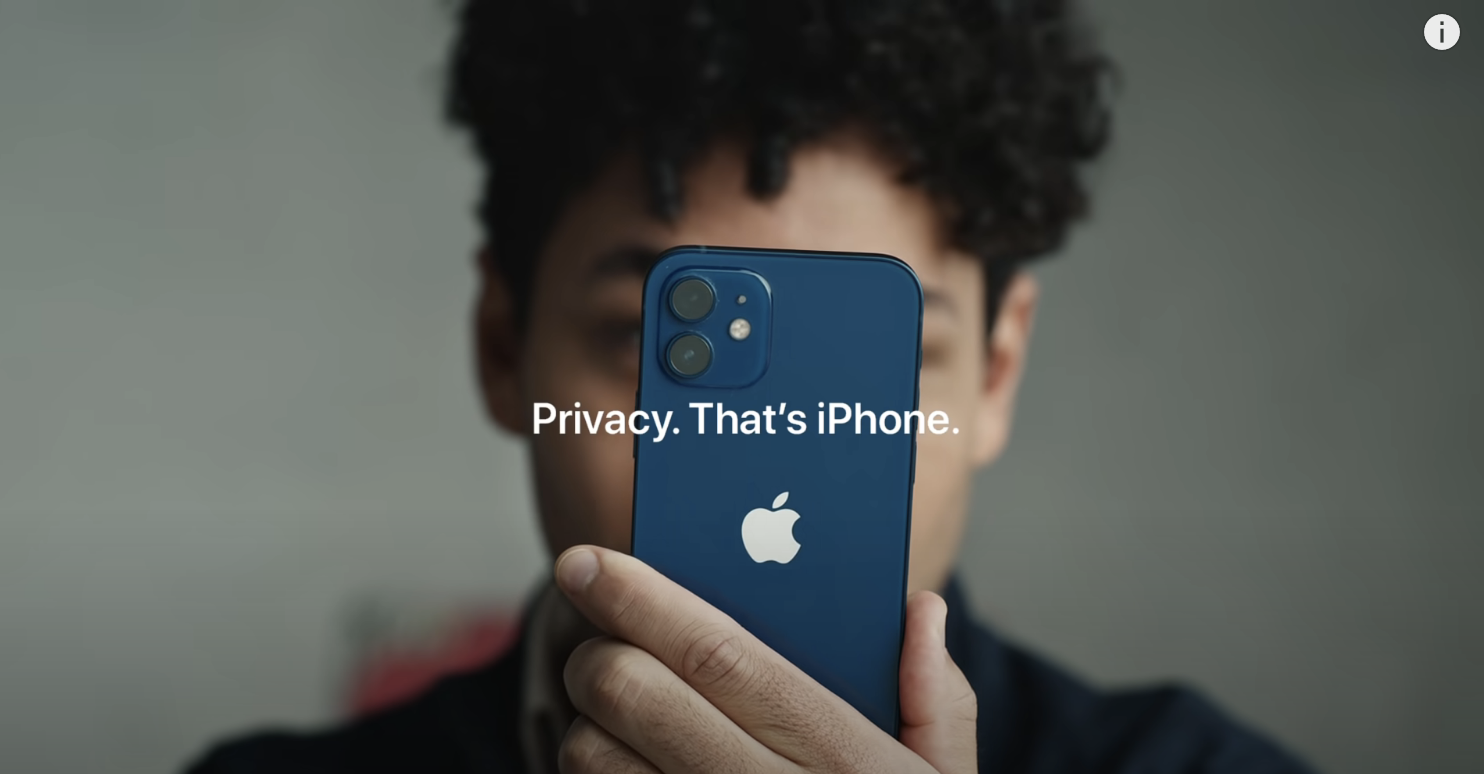
This piece has had a lot of very smart push-back (and forward, but mostly back). I respond to it in Part II, here.
If you haven’t seen it yet, watch Apple’s Privacy on iPhone | tracked ad. In it a guy named Felix (that’s him, above) goes from a coffee shop to a waiting room somewhere, accumulating a vast herd of hangers-on along the way. The herd represents trackers in his phone, all crowding his personal space while gathering private information about him. The sound track is “Mind Your Own Business,” by Delta 5. Lyrics:
Can I have a taste of your ice cream?
Can I lick the crumbs from your table?
Can I interfere in your crisis?No, mind your own business
No, mind your own businessCan you hear those people behind me?
Looking at your feelings inside me
Listen to the distance between usWhy don’t you mind your own business?
Why don’t you mind your own business?Can you hear those people behind me?
Looking at your feelings inside me
Listen to the distance between usWhy don’t you mind your own business?
Why don’t you mind your own business?
The ad says this when Felix checks his phone from the crowded room filled with people spying on his life:

Then this:

Finally, when he presses “Ask App Not to Track,” all the hangers-on go pop and turn to dust—

Followed by

Except that she gets popped too:

Meaning he doesn’t want any one of those trackers in his life.
The final image is the one at the top.
Here’s what’s misleading about this message: Felix would have had none of those trackers following him if he had gone into Settings—>Privacy—>Tracking, and pushed the switch to off, like I’ve done here:
![]()
Key fact: it is defaulted to on. Meaning Apple is not fully serious about privacy. If Apple was fully serious, your iPhone would be set to not allow tracking in the first place. All those trackers would come pre-vaporized. And Apple never would have given every iPhone an IDFA—ID For Advertisers—in the first place. (And never mind that they created IDFA back in 2013 partly to wean advertisers from tracking and targeting phones’ UDIDs (unique device IDs).
Defaulting the master Tracking setting to ON means Felix has to tap “Ask App Not To Track” for every single one of those hangers-on. Meaning that one click won’t vaporize all those apps at once. Just one at a time. This too is misleading as well as unserious.
And why “ask” an app not to track? Why not “tell”? Or, better yet, “Prevent Tracking By This App”? Does asking an app not to track mean it won’t?
History has an answer for those questions.
Remember Do Not Track? Invented in the dawn of tracking, back in the late ’00s, it’s still a setting in every one of our browsers. But it too is just an ask—and ignored by nearly every website on Earth.
Here is how the setting looks, buried deep on Google’s Chrome:

It’s hardly worth bothering to turn that on (it’s defaulted to off), because it became clear long ago that Do Not Track was utterly defeated by the adtech biz and its dependents in online publishing. The standard itself was morphed to meaninglessness at the W3C, where by the end (in 2019) it got re-branded “Tracking Preference Expression.” (As if any of us has a preference for tracking other than to make it not happen or go away.)
By the way, thanks to adtech’s defeat of Do Not Track in 2014, people took matters into their own hands, by installing ad and tracking blockers en masse, turning ad blocking, an option that had been laying around since 2004, into the biggest boycott in world history by 2015.
And now we have one large company, Apple, making big and (somewhat, as we see above) bold moves toward respecting personal privacy. That’s good as far as it goes. But how far is that, exactly? To see how far, here are some questions:
- Will “asking” apps not to track on an iPhone actually make an app not track?
- How will one be able to tell?
- What auditing and accounting mechanisms are in place—on your phone, on the apps’ side, or at Apple?
As for people’s responses to Apple’s new setting, here are some numbers for a three-week time frame: April 26 to May 16. They come from FLURRY, a subsidiary of Verizon Media, which is an adtech company. I’ll summarize:
- For “Worldwide daily op-in rate after iOS 14.5 launch across all apps,” expressed as “% of mobile active app users who allow app tracking among uses who have chosen to either allow or deny tracking” started at 11% and rose to 15%.
- The “U.S. Daily opt-in rate after iOS launch across all apps,” expressed as “% of mobile active app users who allow app tracking among users who have chosen to either allow or deny tracking” started at 2% and rose to 6%.
- The “Worldwide daily opt-in rate across apps that have displayed the prompt,” expressed as “% of mobile active app users who allow app tracking among users who have chosen to either allow or deny tracking” started at 31% and went down to 24%.
- The “Worldwide daily share of mobile app users with ‘restricted’ app tracking” (that’s where somebody goes into Settings—>Privacy—>Tracking and switches off “Allow Apps to Request to Track”), expressed as “% of mobile active app users who cannot be tracked by default and don’t have a choice to select a tracking option” started and stayed within a point of 5% .
- And the “U.S. daily share of mobile app users with ‘restricted’ app tracking,” expressed as “% of mobile active app users who cannot be tracked by default and don’t have a choice to select a tracking option” started at 4% and ended at 3%, with some dips to 2%.
Clearly tracking isn’t popular, but those first two numbers should cause concern for those who want tracking to stay unpopular. The adtech business is relentless in advocacy of tracking, constantly pitching stories about how essential tracking-based “relevant,” “personalized” and “interest-based” advertising is—for you, and for the “free” Web and Internet.
It is also essential to note that Apple does advertising as well. Here’s Benedict Evans on a slope for Apple that is slippery in several ways:
Apple has built up its own ad system on the iPhone, which records, tracks and targets users and serves them ads, but does this on the device itself rather than on the cloud, and only its own apps and services. Apple tracks lots of different aspects of your behaviour and uses that data to put you into anonymised interest-based cohorts and serve you ads that are targeted to your interests, in the App Store, Stocks and News apps. You can read Apple’s description of that here – Apple is tracking a lot of user data, but nothing leaves your phone. Your phone is tracking you, but it doesn’t tell anyone anything.
This is conceptually pretty similar to Google’s proposed FLoC, in which your Chrome web browser uses the web pages you visit to put you into anonymised interest-based cohorts without your browsing history itself leaving your device. Publishers (and hence advertisers) can ask Chrome for a cohort and serve you an appropriate ad rather than tracking and targeting you yourself. Your browser is tracking you, but it doesn’t tell anyone anything -except for that anonymous cohort.
Google, obviously, wants FLoC to be a generalised system used by third-party publishers and advertisers. At the moment, Apple runs its own cohort tracking, publishing and advertising as a sealed system. It has begun selling targeted ads inside the App Store (at precisely the moment that it crippled third party app install ads with IDFA), but it isn’t offering this tracking and targeting to anyone else. Unlike FLoC, an advertiser, web page or app can’t ask what cohort your iPhone has put you in – only Apple’s apps can do that, including the app store.
So, the obvious, cynical theory is that Apple decided to cripple third-party app install ads just at the point that it was poised to launch its own, and to weaken the broader smartphone ad model so that companies would be driven towards in-app purchase instead. (The even more cynical theory would be that Apple expects to lose a big chunk of App Store commission as a result of lawsuits and so plans to replace this with app install ads. I don’t actually believe this – amongst other things I think Apple believes it will win its Epic and Spotify cases.)
Much more interesting, though, is what happens if Apple opens up its cohort tracking and targeting, and says that apps, or Safari, can now serve anonymous, targeted, private ads without the publisher or developer knowing the targeting data. It could create an API to serve those ads in Safari and in apps, without the publisher knowing what the cohort was or even without knowing what the ad was. What if Apple offered that, and described it as a truly ‘private, personalised’ ad model, on a platform with at least 60% of US mobile traffic, and over a billion global users?…
Apple has a tendency to build up strategic assets in discrete blocks and small parts of products, and then combine them into one. It’s been planning to shift the Mac to its own silicon for close to a decade, and added biometrics to its products before adding Apple Pay and then a credit card. Now it has Apple Pay and ‘Sign in with Apple’ as new building blocks on the web, that might be combined into other things. It seems pretty obvious that Privacy is another of those building blocks, deployed step by step in lots of different places. Privacy has been good business for Apple, and advertising is a bigger business than all of those.
All of which is why I’ve lately been thinking that privacy is a losing battle on the Web. And that we need to start building a byway around the whole mess: one where demand can signal supply about exactly what it wants, rather than having demand constantly being spied on and guessed at by adtech’s creepy machinery.
Leave a Reply